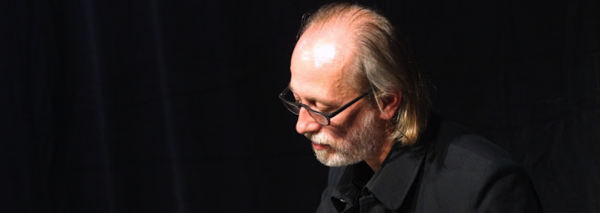László Krasznahorkai was born in Gyula, Hungary, in 1954, and has written five novels and several collections of essays and short stories. Until recently, at least in the English-speaking world, he was probably best known through the oeuvre of the film director Béla Tarr, with whom he has collaborated on several films over three decades, including the adaptation of several of his own novels.
In 2000, the Hungarian-born British poet George Szirtes – who conducted this interview in 2012 by email – translated Krasznahorkai’s The Melancholy of Resistance, the first of his books to appear in English. It was blurbed by Susan Sontag (‘the contemporary Hungarian master of the apocalypse’) and W. G. Sebald (‘The universality of Krasznahorkai’s vision rivals that of Gogol’s Dead Souls and far surpasses all the lesser concerns of contemporary writing.’). Krasznahorkai, who was awarded the 2015 Man Booker International Prize last Tuesday, is widely recognised as one of the very best and important novelists of our time.
So much so that on the occasion of the release of Sátántango, another Szirtes translation, in 2012, the author was mobbed by hipsters at Housing Works Bookstore in New York City, where the critic James Wood was interviewing him. ‘[T]he excitement of Krasznahorkai’s writing is that he has come up with his own original forms…’ writes the novelist Adam Thirlwell in the New York Review of Books. ‘There’s nothing else like it in contemporary literature.’
James Wood, writing in the New Yorker in 2012, placed Krasznahorkai alongside post-war greats such as Thomas Bernhard, Claude Simon and David Foster Wallace. Wood did qualify his comparison though – in spite of a common affinity for ‘very long, breathing, unstopped sentences’, Krasznahorkai is ‘perhaps the strangest’, his writing ‘peculiar … strange and beautiful’.
George Szirtes, who has now translated three of his books into English, calls Krasznahorkai’s work a ‘slow lava flow of narrative, a vast black river of type’. His sentences, he writes, take you down ‘loops and dark alleyways – like wandering in and out of cellars’.
In 2013 New Directions published László Krasznahorkai’s Seiobo There Below (translated by Ottilie Mulzet), the latest of his novels to be translated into English. The novel is published in the UK by Tuskar Rock this month. We are delighted to publish its first chapter, and this short interview with the author.
[The Editors]




